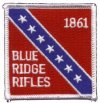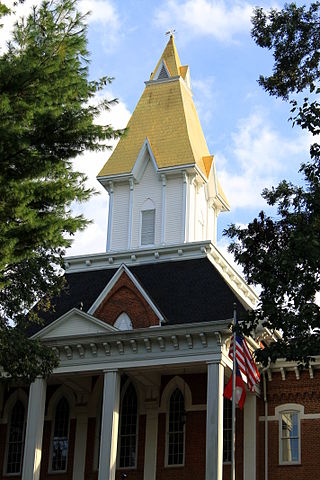
Dahlonega is the county seat of Lumpkin County,Georgia,United States. As of the 2010 census,the city had a population of 5,242,and in 2018 the population was estimated to be 6,884.

The Dahlonega Mint was a former branch of the United States Mint built during the Georgia Gold Rush to help the miners get their gold assayed and minted,without having to travel to the Philadelphia Mint. It was located at in Dahlonega,Lumpkin County,Georgia. Coins produced at the Dahlonega Mint bear the "D" mint mark. That mint mark is used today by the Denver Mint,which opened in 1906,over four decades after the Dahlonega Mint closed. All coins from the Dahlonega Mint are gold,in the $1,$2.50,$3,and $5 denominations,and bear dates in the range 1838–1861.

Augustus Baldwin Longstreet was an American lawyer,minister,educator,and humorist,known for his book Georgia Scenes. He was the uncle of the senior Confederate General James Longstreet. He held pro-slavery and pro-secessionist views,personally owning dozens of slaves throughout his life. He held the presidency positions at several southern universities including,the University of Mississippi (twice),South Carolina College,and Emory College.

Donald Lee Hollowell was an American civil rights attorney during the Civil Rights Movement,in the state of Georgia. He successfully sued to integrate Atlanta's public schools,Georgia colleges,universities and public transit,freed Martin Luther King Jr. from prison,and mentored civil rights attorneys. The first black regional director of a federal agency,Hollowell is best remembered for his instrumental role in winning the desegregation of the University of Georgia in 1961. He is the subject of a 2010 documentary film,Donald L. Hollowell:Foot Soldier for Equal Justice.

The Blue Ridge Rifles,established in 1950,is a military precision drill team within the ROTC program at the University of North Georgia. It is not directly affiliated with the Blue Ridge Rifles that existed as a military unit of the Confederate States Army during the Civil War,but drew its name in memory of that unit that stood up from the local area.

Alexander Quarles Holladay LL.D. was an American lawyer,state senator and college administrator.

Patrick Hues Mell was the president of the Southern Baptist Convention in two terms from 1863 to 1871 and from 1880 to 1887. He also served as chancellor of the University of Georgia (UGA) in Athens from 1878 until his resignation in 1888..

Jonathan Clark Rogers was President of the University of Georgia (UGA) in Athens from 1949 until 1950.

Blake Ragsdale Van Leer was an engineer and university professor who served as the fifth president of Georgia Institute of Technology from 1944 until his death in 1956.

The Georgia Gold Rush was the second significant gold rush in the United States and the first in Georgia,and overshadowed the previous rush in North Carolina. It started in 1829 in present-day Lumpkin County near the county seat,Dahlonega,and soon spread through the North Georgia mountains,following the Georgia Gold Belt. By the early 1840s,gold became difficult to find. Many Georgia miners moved west when gold was found in the Sierra Nevada in 1848,starting the California Gold Rush. Since the 16th century,American Indians in Georgia told European explorers that the small amounts of gold which they possessed came from mountains of the interior. Some poorly documented accounts exist of Spanish or French mining gold in North Georgia between 1560 and 1690,but they are based on supposition and on rumors passed on by Indians. In summing up known sources,W.S. Yeates observed:"Many of these accounts and traditions seem to be quite plausible. Nevertheless,it is hardly probable that the Spaniards would have abandoned mines which were afterwards found to be quite profitable,as those in North Georgia."

William Pierce Price was a politician who served in the United States House of Representatives. Price was born in Dahlonega,Georgia.
Ernest Neal (1858–1943),was an American poet and educator. He was the 2nd Poet Laureate of Georgia. He lived in Dahlonega for some time,but Calhoun,Georgia was his home.
North Georgia College &State University was an institution of higher education that began as a branch of the Georgia College of Agriculture and Mechanical at the University of Georgia in 1873. It was merged in 2013 with Gainesville State College to create the University of North Georgia.

The University of North Georgia (UNG) is a public senior military college with multiple campuses in Georgia,United States. It is part of the University System of Georgia. The university was established on January 8,2013,by a merger of North Georgia College &State University and Gainesville State College. Campus locations include Dahlonega,Oakwood,Watkinsville,Blue Ridge,and Cumming.
The University of North Georgia was first established at the site of its current campus in Dahlonega,Georgia in 1873 as North Georgia Agricultural College (NGAC). In 2013 North Georgia College &State University was consolidated with Gainesville State College to form the University of North Georgia.

William Starr Basinger (1827–1910) was a lawyer,military officer,state legislator,and the president of the University of North Georgia. He served as a major in the 18th Georgia Battalion of the Confederate States Army during the Civil War. In 1886 Basinger,succeeding David W. Lewis,became the second president of North Georgia Agricultural College.

Isaac Watts Waddell was a Presbyterian pastor in Brunswick,GA and the third president of the North Georgia Agricultural College. He is the grandson of former University of Georgia president Moses Waddel.
John H. Owen was the twelfth president of the University of North Georgia (UNG) and a lieutenant commander in the United States Navy during the Second World War. He was the president of UNG for twenty-two years,longer than any other president in the university's history.

Price Memorial Hall,also known as the Price Memorial Building,is a historic site in Dahlonega,Georgia. The hall was built on the site of the U.S. government's federal branch mint built in 1836. It burned down in 1878 and the university,one of the first Federal Land Grant Colleges,had its hall built on the foundation. A historical marker is located on the site.

Fields Place-Vickery House is a historic building located in Dahlonega,Georgia. It is listed on the National Register of Historic Places.
















